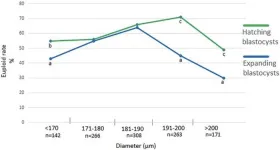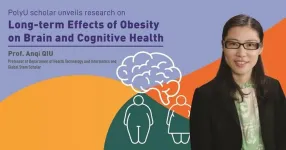(Press-News.org) A new study reports the first direct observation of merging star clusters in the nuclear region of dwarf galaxies. This detection confirms the feasibility of this formation route for nuclei in dwarf galaxies, which has long been debated. The study was published in Nature science journal, and led by Postdoctoral Researcher Mélina Poulain from the University of Oulu, Finland.
Dwarf galaxies are the most abundant type of galaxies that populate the Universe. Composed of 100 times fewer stars than the Milky Way, or even less, they are the building blocks of more massive galaxies. Thus, understanding their formation is key to comprehend galaxy evolution.
A notable fraction of dwarf galaxies host a compact star cluster at their centers, typically made of hundreds of thousands to hundreds of millions of stars. Known as nuclear star clusters, these are the densest type of stellar systems in the Universe. The formation of such extreme objects has been under debate for several decades. In dwarf galaxies, they are believed to form from the merger of smaller star clusters, called globular clusters, after they migrate to the galaxy center. However, no such merger of globular clusters has been directly observed to confirm the theory, until now.
Witnessing rare features
While studying observations of a large sample of nearly 80 dwarf galaxies from the Hubble Space telescope, which were led by Prof. Francine Marleau at the University of Innsbruck, Austria, a group of ten researchers from the international MATLAS collaboration noticed a handful of galaxies with an unusual looking nuclear star cluster. Some showed a couple of star clusters close together, while others had a feature similar to a faint stream of light attached to the nuclear star cluster.
“We were surprised by the streams of light that were visible near the center of the galaxies, as nothing similar has been observed in the past”, explains Mélina Poulain.
A thorough analysis of the features has shown that they have similar properties to globular clusters already detected in dwarf galaxies. This suggests that the observations witness the growth of the nuclear star cluster by the dramatic cannibalization of globular clusters at the cores of those galaxies.
Observations reproduced in simulations
To confirm the origin of the faint streams of light, ultra-high resolution complementary simulations were implemented to model the merging process. This portion of the work, led by Dr. Rory Smith at the Universidad Técnica Federico Santa María in Santiago, Chile, set up various mergers between star clusters with differing masses, dynamics, and numbers of clusters involved. Results confirm that the observed light streams are created with two star clusters with significant mass differences merge. The larger the mass ratio, the longer the stream. The process typically lasts a short amount of time, less than 100 million years, and the features produced are visible for even less time, which explains the difficulty of catching such a phenomenon.
The new study is part of Poulain’s research project, funded by the Research Council of Finland. The study was published on 9 April 2025 in the prestigious journal Nature: Reference
Learn more about space physics and astronomy research at the University of Oulu
END
Hubble Space telescope unveils the first images of ongoing star cluster mergers near the center of dwarf galaxies
2025-04-09
ELSE PRESS RELEASES FROM THIS DATE:
‘Sugar’ signatures help identify and classify pancreatic cancer cell subtypes
2025-04-09
GRAND RAPIDS, Mich. (April 9, 2025) — Van Andel Institute scientists and collaborators have developed a new method for identifying and classifying pancreatic cancer cell subtypes based on sugars found on the outside of cancer cells.
These sugars, called glycans, help cells recognize and communicate with each other. They also act as a cellular “signature,” with each subtype of pancreatic cancer cell possessing a different composition of glycans.
The new method, multiplexed glycan immunofluorescence, combines ...
Every cloud has a silver lining: DeepSeek’s light through acute respiratory distress syndrome shadows
2025-04-09
Acute respiratory distress syndrome (ARDS) continues to be a tough nut to crack in critical care, taking lives despite years of research and better ventilator strategies. It is defined by acute hypoxemia, bilateral infiltrates on chest imaging, and non-cardiogenic pulmonary edema, and it remains a heterogeneous condition with mortality rates stubbornly close to 40%. Its complexity—spanning diverse etiologies, inflammatory profiles, and therapeutic responses—demands innovative solutions beyond traditional paradigms. In recent years, artificial intelligence ...
Scientific Program announced for inaugural eLTER Science Conference in Finland
2025-04-09
The scientific programme for the inaugural eLTER Science Conference has just been launched, marking a major milestone in the lead-up to the event. Held from 23 to 27 June 2025 in Tampere, Finland, the conference will explore integrated, policy-relevant approaches to ecosystem and socio-ecological research under the theme: “Toward a whole-system approach to ecosystem science.”
Organised by the Integrated European Long-Term Ecosystem, critical zone and socio-ecological systems Research Infrastructure (eLTER RI), the event is expected to welcome over 300 participants from across Europe and beyond.
The scientific programme features:
25 keynote speakers recognised for their leadership ...
Does blastocyst size matter? Exploring reproductive aging and genetic testing
2025-04-09
“[…] when selecting non-PGT-A tested embryos for embryo transfer (ET) or frozen embryo transfer (FET), a small hatching blastocyst seems to be a better choice than a large expanded one, especially for advanced-age patients for whom the risk of aneuploidy is higher.”
BUFFALO, NY — April 9, 2025 — A new research paper was published in Aging (Aging-US) Volume 17, Issue 3, on March 5, 2025, titled “Reproductive aging, preimplantation genetic testing for aneuploidy, and the diameter of blastocysts: does size matter?”
In this study, a team led by first author Jakub Wyroba from the Malopolski Institute of Fertility Diagnostics ...
2025 EurekAlert! Travel Awards for International Science Reporters applications now open
2025-04-09
Applications for the 2025 EurekAlert! Travel Awards for International Science Reporters are now open to early-career science journalists from Brazil and countries in Eastern Europe. Two winners will be selected to receive travel funding from EurekAlert! to attend the 2026 AAAS Annual Meeting, taking place February 12-14, 2026 in Phoenix, Arizona, USA. Learn more about who is eligible and how to apply on our website. The application deadline is May 5 at 11:59 p.m. U.S. Eastern Time.
Learn More and Apply!
The American Association for the Advancement of Science (AAAS) is the world’s largest multidisciplinary scientific society, and the AAAS Annual Meeting brings together ...
Menstrual cycle may contribute to sickle cell disease pain crises
2025-04-09
(WASHINGTON— April 9, 2025) — A marker linked to inflammation, C-reactive protein, may increase significantly during the follicular phase of the menstrual cycle in female patients with sickle cell disease (SCD), according to emerging research published today in Blood Vessels, Thrombosis & Hemostasis. This observation provides insight into the pattern of painful vaso-occlusive events (VOEs), which are driven by inflammation, in female patients with the disorder.
“We know both from the literature and anecdotally from our patients that women with SCD have VOEs that cluster ...
PolyU scholar unveils research on long-term effects of obesity on brain and cognitive health
2025-04-09
With the global prevalence of obesity on the rise, it is crucial to explore the neural mechanisms linked to obesity and its influence on brain and cognitive health. However, the impact of obesity on the brain is complex and multilevel. To address this, Prof. Anqi QIU, Professor of the Department of Health Technology and Informatics at the Hong Kong Polytechnic University (PolyU) and Global STEM Scholar, has unveiled novel research to advance our understanding of the neural mechanisms underlying the relationship between obesity and its implications for cognitive health in adults.
Obesity ...
Comprehensive Keck Medicine of USC medical office building coming soon to Pasadena
2025-04-09
LOS ANGELES — Keck Medicine of USC will open a four-story, 100,000 square-foot, state-of-the-art medical office building located at 590 S. Fair Oaks Ave. in Pasadena in fall 2025.
As the newest addition to the renowned academic health system, the location will significantly expand Keck Medicine clinical care for residents of Pasadena and neighboring communities in the San Gabriel Valley.
What sets the new Pasadena location apart
“This new location — our largest and most advanced outpatient setting — will ...
Contagious quitting? New USF-led study links peer behavior to employee turnover
2025-04-09
TAMPA, Fla. (April 9, 2025) – A new study led by the University of South Florida and the University of Cincinnati sheds light on the powerful impact of workplace cohorts on newcomer retention. The findings provide critical insights for organizations seeking to reduce employee turnover and improve stability among their teams.
Cohorts, groups of new employees that join an organization at the same time and are usually trained together, are common in the military and in professional services such as law, accounting and consulting firms. ...
Man’s best friend may be nature’s worst enemy, study on pet dogs finds
2025-04-09
New Curtin University research into the overlooked environmental impact of pet dogs has found far-reaching negative effects on wildlife, ecosystems and climate.
While ecological damage caused by cats has been extensively studied, the new research found dogs, as the world’s most common large carnivores, present a significant and multifaceted environmental threat.
Lead researcher Associate Professor Bill Bateman, from Curtin’s School of Molecular and Life Sciences, said the research found that human-owned, pet dogs disturb and directly harm wildlife, particularly shorebirds, even when leashed.
“As well as predatory behaviour like chasing wildlife, ...





